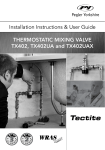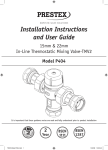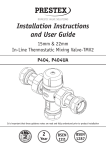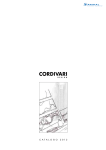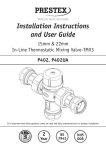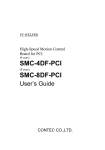Download INSTALLATION & OPERATING INSTRUCTIONS
Transcript
INSTALLATION & OPERATING INSTRUCTIONS • INSTALLATION & OPERATING INSTRUCTIONS • INSTALLATION & OPERATING INSTRUCTIONS Introduction General installation The following information is provided to ensure that users achieve the maximum benefit from their Mistral radiator valves. Please read these general installation instructions carefully before proceeding. Further detailed instructions are found in individual product sections. Preliminaries 1. Select the appropriate Mistral product for installation. Ensure that the size of body chosen will allow sufficient flow of water to meet the heat demands of the room. Also ensure that the valve chosen is correct for the pipe size used in the installation. To ensure that Mistral TRVs function correctly, i.e. provide individual room temperature control, the central heating system and all radiators installed should provide sufficient heat to raise room temperatures to maximum required levels. 2. Prior to installation ensure the system is free from debris and contamination. TRVs should not be used in areas where individual room thermostats already provide temperature control, or where central thermostatic control of the system is located. Kv and Kvs values The Kv value of a valve, as displayed in this document, indicates the volume of flow in m3/h at a determined stroke (control difference) and a pressure loss of 1.0 bar. The Kvs value indicates the volume of flow when the valve is completely open. 3. The black protective cap, supplied with Mistral and Mistral Pro TRVs, can be used as a temporary ON/OFF controller before the thermostatic sensor head is fitted. It can also be used as a “decorators cap”. 4. All Mistral and Mistral Pro TRVs are calibrated in controlled conditions where position III equates to approximately 20°C. Installation 1. Fit the union tail to the radiator ensuring that sufficient PTFE tape, or other suitable sealant, is applied to the threads. Connect the valve body to the union tail making sure that the direction of the arrows, on the valve body, follows the direction of the water flow. There are two methods of assembling the Kuterlite ends of Mistral radiator valves Step 2 Tighten the nut by finger and then by spanner until the tube cannot be rotated in the fitting by hand. Always use a high quality open ended or adjustable spanner. Step 1a Insert the tube firmly into the compression fitting without removing the compression nut and ring, ensuring that the compression ring seats centrally and that the tube makes firm contact with the tube stop in the body of the fitting. Step 3 Tighten the nut a further 1⁄3 to 2⁄3 of a turn for normal joint making (an arrowhead stamped on the face of the nut provides a reference point for tightening). Some variation may be necessary when jointing stainless steel tube and Table Y copper tube. If there is any slight leakage, particularly if the joint has been disturbed after assembly, the nut may be tightened further as necessary. However, over tightening the compression nut will not result in a stronger joint and may lead to problems in service. Connect the pipe to the radiator valve following steps 1a – 3 adjacent. Temperature settings 10-12°C Stairway Mistral manual 14°C Night time Size range 15-18°C Bedroom Mistral Manual radiator valves are available in three sizes, 8mm x 1⁄2"BSP, 10mm x 1⁄2"BSP and 15mm x 1⁄2"BSP. 8mm 10mm 15mm 19-22°C Living/dining Building in dimensions for Mistral Manual fitted with wheelhead or lockshield Installation See general installation instructions. IIII 22-25°C Bathroom IIIII I 22 6°C Frost protection 4. In the event that a radiator needs to be removed, we recommend fitting an additional blanking cap, from the Mistral accessories range, to the valve body. This will prevent any possibility of unwanted water leakage. II 0°C 3. When the installation is complete and the system is running normally, adjust the thermostatic heads to the preferred setting in individual rooms. Step 1b Remove the compression nut and compression ring and put the nut and then the ring on the tube. Insert the tube end up to the tube stop in the fitting, ensuring that the compression ring seats centrally. Slide both ring and nut up to the fitting body. III Off The following diagram shows the relationship between the settings on the Mistral and Mistral Pro TRV head and the approximate room temperature achieved. 2. Unscrew protective black cap when ready to fit the Mistral TRV head. Before fitting thermostatic heads, adjust setting to position IIIII, then fit to the valve body and screw down tightening nut until secure. 26-29°C Swimming pool Size A B C 59mm 59mm 59mm 30mm 30mm 30mm 54mm 54mm 54mm Fitting Thermostatic Heads Adjust setting to position IIIII and fit to the valve body, screw down the locking nut and secure (do not over tighten). When the installation is complete and the system is running normally, adjust the thermostatic heads to the preferred setting in individual rooms. If installing a Mistral TRV, snap on the decorative cover which is supplied loose. Performance The Mistral Manual radiator valve provides the following flow characteristics under standard operating conditions. Size 8mm, 10mm, 15mm Maximum Temperature Maximum Pressure 120°C 10 bar 097063 V2/0306 EN 215 Working pressures and temperatures INSTALLATION & OPERATING INSTRUCTIONS • INSTALLATION & OPERATING INSTRUCTIONS • INSTALLATION & OPERATING INSTRUCTIONS Mistral TRV Mistral Pro TRV Size range Mistral TRVs are available in three sizes, 8mm x 1⁄2"BSP, 10mm x 1⁄2"BSP and 15mm x 1⁄2"BSP. Size range The Mistral Pro TRV is available in 15mm x 1⁄2"BSP. To use with 10mm or 8mm copper tube use Kuterlite 648 reducing sets. Building in dimensions for Mistral TRV Re-setting If for any reason the original setting of the thermostatic head has been lost it can be restored as follows: 1. Remove the economy clip. Building in dimensions for Mistral Pro TRV 2. Set the head to position IIIII. Insert the sensor cover removal tool into the ventilation slots and remove the cover with a sharp pull. 3. Rotate the exposed sensor head 180° anti-clockwise and lift the setting ring. 3. Turn the exposed head clockwise to the stop, then anti-clockwise until the calibration notch aligns with position 3 as marked on the head internals. 4. Replace the cover, aligning number III on the scale with the setting arrow and press firmly to snap the cover back into place. 5. Replace the economy clip. If for any reason the sensor head has been completely unscrewed the original setting can be restored as follows. These instructions vary slightly for the Mistral Pro head and Mistral Pro remote sensor. All sizes Fitted vertically Fitted horizontally A B C 100mm 28mm 50mm 100mm 32mm 47mm All sizes 15mm fitted vertically 15mm fitted horizontally A B C 107mm 28mm 50mm 107mm 32mm 47mm Installation See general installation instructions. Installation See general installation instructions. Operation Limiting the maximum setting To achieve this attach the thermostatic head and set the temperature to the maximum desired position. Remove the black retention pin, found underneath the setting arrow, and re-insert into the slot directly underneath position IIIII. The temperature adjustment has been limited to the set point. Operation Using the black economy clip The thermostatic head is supplied with an economy clip which may be used to restrict the maximum temperature as follows: Locking a predetermined setting To lock a predetermined setting carry out the limiting maximum setting procedure as detailed above. Then remove the retention pin positioned under setting IIIII, and replace it two slots to the left. The desired set temperature is now locked. Working pressures and temperatures Size 8mm 10mm 15mm A B C 120°C 10 bar 1 bar 120°C 10 bar 1 bar 120°C 10 bar 1 bar Performance The Mistral TRV provides the following flow characteristics under standard operating conditions. 4. Align the setting ring with the setting arrow, i.e. the right hand edge of the limit stop (to the right of the locking slot), immediately to the left of setting 2 marked on the head internals. Mistral Pro series 1. Insert the setting ring making sure that the base pin engages in the setting ring slot. 2. Position the sensor head to the respective head base aligning the adjustment notch with the setting arrow. Now screw the head clockwise to the stop, pressing lightly. 3. Unscrew the sensor head until the setting notch lines up with setting 3, marked on the head internals. 1. Slide the economy clip back with the thumb as far as it will go. Lift the rear end of the clip and remove from the thermostatic head. 4. Replace the cover, aligning the numeral 3 on the scale with the setting arrow and press firmly to snap the cover into place. 2. Rotate the thermostatic head until the desired maximum setting aligns with the setting arrow. Mistral Pro remote sensor 1. Insert the setting ring making sure to line up the limit stop of both the setting ring and base. 3. Next insert the economy clip in the corresponding slot and push in gently. 5. Re-insert the setting ring and press it firmly into place. 4. The thermostatic head can now be rotated to any setting up to the set limit. Working pressures and temperatures The economy clip can also be used as a setting marker, or may be removed altogether by lifting it out of the slot if it is not required. Size 15mm In addition to the economy clip the Mistral Pro features a locking and limiting device. Limiting the maximum setting This example illustrates how to limit the Mistral Pro TRV to position II. 1. Remove the economy clip. 2. Set the head to position IIIII. Insert the cover removal tool into the ventilation slots of the cover. Pull sharply and remove the cover to expose the headwork and setting ring in initial position. Follow instructions 2-4 as above. Maximum temperature Maximum pressure Maximum differential pressure 120°C 10 bar 1 bar Performance The Mistral Pro TRV provides the following flow characteristics under standard operating conditions. 6. Screw in the sensor head clockwise as far as it will go, then unscrew until the calibration notch lines up with the limit stop, the setting arrow and setting 2. 7. Replace the cover making sure that the number II lines up with the setting arrow. 8. Press firmly on the cover to snap it into place. Other settings are achieved in similar fashion. Locking a predetermined setting This example illustrates how to lock the Mistral Pro TRV to position II. Carry out procedures 1 – 3 for restricting the maximum setting. Then proceed as follows: 4. Align setting ring locking slot with setting 2 marked on the head internals. Kv valve (m3⁄h) Size 8mm 10mm 15mm Control difference (K) 1 1.5 2 2.5 3 0.25 0.25 0.25 0.37 0.37 0.37 0.49 0.49 0.49 0.58 0.58 0.58 0.66 0.66 0.66 Kvs Carry out steps 5 – 8 as for restricting the maximum setting. 0.95 1.15 1.35 Setting II has been locked in place. Other settings are achieved in similar fashion. Kv valve (m3⁄h) Control difference (K) Size 15mm Kvs 1 1.5 2 2.5 3 0.25 0.37 0.49 0.58 0.66 1.35 INSTALLATION & OPERATING INSTRUCTIONS • INSTALLATION & OPERATING INSTRUCTIONS • INSTALLATION & OPERATING INSTRUCTIONS Automatic Bypass Valves Mistral Pro heads The Mistral Pro head Detailed technical information, installation and operating instructions can be found in the Mistral Pro TRV section. Mistral Pro remote sensor Detailed technical information, installation and operating instructions can be found in the Mistral Pro TRV section. Once the valve and head have been installed the remote sensor bulb should be fitted as follows: 1. Fix the mounting bracket horizontally or vertically as required. 2. Place sensor into the holder and snap the assembly into the mounting bracket. 3. Lay the capillary tube. 4. Carefully coil surplus capillary tubing on the reel provided and cover with protective cap. Never attempt to cut or shorten the capillary tube. Mistral Pro remote head Once the valve body has been installed adhering to the appropriate instructions the remote head should be fitted as follows: 1. First ensure that the remote head will not be covered by curtains or furniture as this will adversely affect the performance of the thermostatic sensor. 2. Carefully prise off the sensor cover with a screwdriver inserted through the drilling in the underside, remove the cover from the base plate. 3. Next, fix the base plate to a flat wall or onto a 60mm wall box with the screws provided, ensuring that the arrow is pointing upwards. 4. Measure the required length of capillary tube which may be buried in the plaster or alternatively run in a 23mm conduit. Wind any surplus around the hooks on the front face of the base plate. When mounting on a flat wall it is important to make sure the capillary tube is carefully lead out through one of the slots provided. 5. With scale mark III to the top press the cover firmly onto the base plate until it snaps into place. Never attempt to cut or shorten the capillary tube. Installation of the capillary tube in the conduit 1. Carefully unscrew the retaining nut from the thermostat actuator housing and withdraw the capillary tube together with the thermostat actuator. 2. Push a lead wire through the conduit and attach it to the thermostat actuator. Then using the lead wire draw the actuator and the capillary tube back through the conduit. 3. Re-assemble the individual components. 4. Unscrew the protective cap from the thermostatic valve body only when ready to fit thermostatic head. 5. Set the Mistral Pro Remote head to setting IIIII then fit the thermostat actuator housing to the valve body and tighten until secure. 6. When the installation is complete and the system is running normally, adjust the thermostatic head to the preferred setting. Size range The Mistral Automatic Bypass Valve is available in 3⁄4", 1" and 11⁄4" sizes. Features Mistral Pro Mistral Pro Mistral Pro head remote sensor remote head Temperature range Mistral Pro anti-tamper head Mistral Pro anti-theft head 6°C - 28°C 6°C - 27°C 8°C - 27°C 8°C - 26°C 6°C - 28°C Maximum sensor temperature 50°C 50°C 50°C 50°C 50°C Sensor Liquid Liquid Liquid Liquid Liquid Range 0 – IIIII 0 – IIIII I – IIIII I – IIIII 0 – IIIII Yes Yes No No Yes +6°C +6°C +8°C +8°C +6°C Anti-theft device No No No Yes Yes Tamperproof temperature locking Yes Yes Yes Yes Yes Tamperproof temperature limiting Yes Yes Yes Yes Yes Economy clip Yes Yes No No Yes Positive shut off Yes Yes No No Yes Hysteresis 0.2K 0.2K 0.5K 0.2K 0.5K No 2m 2m No No Night time setting Frost setting Capillary length Restricting the maximum setting 1. Set the handwheel with the arrow aligned with the desired maximum setting and remove the cover from the base plate. Mistral Pro anti-tamper head Once the valve body has been installed adhering to the appropriate instructions the anti-tamper head should be fitted as follows: 2. Take the red stop pegs from the accessory pack and insert one with the narrow side down into the locking groove in the handwheel to the left of the detente. 1. Remove central cap covering the adjuster with a small screwdriver, insert the setting tool into the opening and turn the head anti-clockwise until it reaches the stop. 3. Replace the cover pressing firmly until it snaps into place. 2. Screw the thermostatic head clockwise onto the valve body until resistance is felt. Continue turning until the retaining screw hole aligns with one of the two marks on the rim of the retaining nut. This ensures that the hole is aligned with the tapping for the locking screw, which is also aligned with the mark. Locking a desired setting 1. Set the handwheel so the arrow is aligned with the desired setting. 2. Carefully prise off the sensor cover with a screwdriver inserted through the drilling in the underside. 3. Take the red stop pegs from the accessory pack and insert them with the narrow side down into the locking grooves in the handwheel, one to the left and one to the right of the detente. Replace the cover pressing firmly until it snaps into place. The desired setting in now locked in place. Important Should the setting mark ever be removed from its guide, it must be reinserted over the red calibration dot, which is exposed on its removal. Mistral Pro anti-theft head Once the valve body has been installed adhering to the appropriate instructions the anti-theft head should be fitted as follows: 1. Unscrew the protective cap from the valve body. 2. Adjust the thermostatic head to setting IIIII and fit to the valve body. 3. Screw down and tighten in line with instructions for standard head. 4. After installation, remove the clip from the anti-theft ring with a screwdriver. The anti-theft ring now rotates freely preventing the unwanted removal of the head. 3. Insert a 2mm allen key and, with the key in place fully tighten the thermostatic head. 4. Using the allen key, turn the retaining screw into the retaining nut as far as it will go. If the handwheel is now rotated it will not affect the setting. 5. Using the setting key adjust valve to preferred setting, viewed through the top of the thermostatic head. Finally, replace central cap. Building in dimensions Size A B C ⁄" 1" 11⁄4" 85mm 32mm 40mm 90mm 37mm 48mm 90mm 46mm 55mm 34 Installation Select the appropriate bypass valve for the system conditions using the performance charts provided. The Mistral ABV should be installed, as close to the pump as is practical, between the flow and return, with the flow in the direction of the arrow. Operation Supplied with a standard factory setting of 200mbar, adjustment to suit individual systems can be achieved by first releasing the securing screw and then turning the handwheel to the desired position between 50mbar and 500mbar. Working pressures and temperatures Size All sizes Maximum temperature Maximum pressure 120°C 10 bar Performance The Mistral Automatic Bypass Valve provides the following flow characteristics under standard operating conditions. INSTALLATION & OPERATING INSTRUCTIONS • INSTALLATION & OPERATING INSTRUCTIONS • INSTALLATION & OPERATING INSTRUCTIONS Valve bodies Installation Fit appropriate valve bodies to the radiator making sure that the direction of the arrows, as indicated on the valve body, follows the direction of the water flow. Once installed unscrew the black protective cap from the thermostatic valve body only when ready to fit the selected thermostatic head. Working pressures and temperatures Size Max temperature Max Pressure Max. differential pressure 12 ⁄" ⁄" 120°C 10 bar 1 bar 34 120°C 10 bar 1 bar Performance Mistral Pro valves provide the following flow characteristics under standard operating conditions. Where Mistral Pro lockshield valves have been installed, contractors may balance the system using the white lockshield valve cap provided. Adjustment of the valve is achieved by inverting the white lockshield cap which is then located in the lugs found on the valve insert. Adjust as necessary by turning the valve clockwise to close and anti-clockwise to open. Mistral Pro thermostatic bodies Fitting tool General trouble shooting Size range The Mistral insert fitting tool is supplied in one size which fits all valves. Where the required room temperature is not reached, or is not maintained installers should check the following: 1. Is the radiator of sufficient size for the area to be heated? Operating instructions 1. Remove the thermostatic head from the valve body and retain for later use. Next, slightly loosen the valve insert with a 19mm box spanner and screw the fitting tool onto the valve body. Ensure the green drain tap is closed at this point. 3. Is the head fully screwed on? Where excessive noise can be heard in the heating system: 1. Ensure that the maximum differential pressure has not been exceeded. Kv valve (m3⁄h) Control difference (K) Size ⁄" 3⁄4" 12 Kvs 1 1.5 2 2.5 3 0.25 0.40 0.37 0.60 0.49 0.79 0.58 0.98 0.66 1.26 1.35 2.50 Mistral Pro lockshield bodies 2. Open the T handled ball valve and push the fitting tool spindle in, engaging it positively on the valve insert. Turn the assembly tool handwheel anti-clockwise until the valve insert has been removed from the body, and then slowly withdraw it as far as it will go. Close the T handled ball valve. Attach the drain off valve by first withdrawing the central black knob and continue until satisfied that the valve is fully secure. Locate the drain valve probe onto the valve insert and then turn anti-clockwise to release the fluid held within the radiator. Additional blanking caps can be used to provide extra protection from unwanted water leakage. BS 2767 – manually operated valves BS EN215 – thermostatic radiator valves BS 7556 – connections for thermostatic radiator valves Control difference (K) Size ⁄" ⁄" 12 34 15mm vertical pattern 22mm vertical pattern 65mm 26mm 58mm 68mm 29mm 66mm 15mm straight pattern 22mm straight pattern 42mm N/A 80mm 42mm N/A 91mm Valve A Vertical 15mm x 1⁄2" 22mm x 3⁄4" Horizontal 15mm x 1⁄2" B C A B Kvs 1 2 3 4 0.09 0.09 0.52 0.52 1.15 1.15 1.79 1.89 2.09 2.34 EN 1254 – capillary fittings (part 1) and compression fittings (part 2) 3. Open the green drain tap remembering to catch any waste water. 4. Unscrew the spindle on the fitting tool, remove the old valve insert and replace it with the new one. Assemble the new insert into the valve body by reversing the removal procedure. BS 21/ISO 7 – pipe threads BS EN IS0 9001:2000 – quality systems 5. After completion drain and remove the fitting tool and firmly tighten the valve insert with a 19mm box spanner. Replace the thermostatic head and set to the desired position. Mistral Pro anti-tamper head Mistral Pro 3. Install an appropriately sized Mistral automatic bypass valve. Where appropriate the following standards are applicable to the Mistral product range: Kv valve (m3⁄h) C 2. Ensure that the valve is installed correctly with the flow direction as indicated. Standards and approvals Building in dimensions for Mistral Pro lockshield bodies B 4. Is the radiator poorly positioned in relation to the heat sensor, i.e. behind a heavy curtain, behind radiator panelling or in a bay window or alcove? 2. Is the valve seat clean and free of contamination? Close the valve, by first inverting the white lockshield cap which is then located in the lugs found on the valve insert. Turn clock-wise until no further movement is possible. Before locating the drain valve ensure that a suitable vessel or hose is available to capture the fluid held within the radiator. A 3. Is the pipework sized correctly? Where the thermostat will not shut off check the following: 1. Has the maximum allowed differential pressure been exceeded? Drain off facility Where Mistral Pro lockshield valves have been installed contractors may drain individual radiators, without draining the whole system, using a combination of the Mistral drain off valve, and the discreet in-built drain off facility, incorporated within each Mistral Pro lockshield valve, as follows: Valve 2. Is the system running at the design temperature? C Mistral Pro anti-theft head Mistral Pro remote sensor A A B C B C Mistral Pro remote head A B C 107mm 36mm 58mm 107mm 36mm 58mm 107mm 36mm 58mm 107mm 36mm 58mm 80mm 36mm 58mm 107mm 39mm 66mm 107mm 39mm 66mm 107mm 39mm 66mm 107mm 39mm 66mm 80mm 39mm 66mm 107mm 38mm 58mm 107mm 38mm 58mm 107mm 38mm 58mm 107mm 38mm 58mm 80mm 38mm 58mm Straight 15mm x 1⁄2" 22mm x 3⁄4" 107mm N/A 105mm 107mm N/A 105mm 107mm N/A 105mm 107mm N/A 105mm 80mm N/A 105mm 107mm N/A 116mm 107mm N/A 116mm 107mm N/A 116mm 107mm N/A 116mm 80mm N/A 116mm Reversible 15mm vertical 22mm horizontal 107mm 28mm 50mm 107mm 28mm 50mm 107mm 28mm 50mm 107mm 28mm 50mm 107mm 28mm 50mm 107mm 32mm 47mm 107mm 32mm 47mm 107mm 32mm 47mm 107mm 32mm 47mm 107mm 32mm 47mm Contact UK Sales: Free Phone 0800 156 0010 UK Sales: Free Fax 0808 156 1011 Technical Help: Free Phone 0800 156 0050 Technical Help: Free Fax 0808 156 1012 Pegler Yorkshire St. Catherine’s Avenue, Doncaster, South Yorkshire, DN4 8DF. www.pegleryorkshire.co.uk




